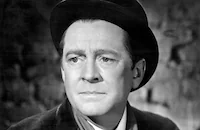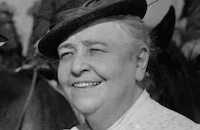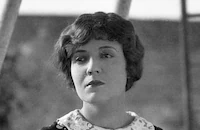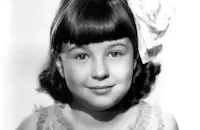Bright Eyes

Brief Synopsis
Cast & Crew
David Butler
Shirley Temple
James Dunn
Jane Darwell
Judith Allen
Lois Wilson
Film Details
Technical Specs

Synopsis
Five-year-old Shirley Blake, whose father, an aviator, died in a crack up, lives with her mother Mary, a maid in the home of the snooty nouveau-riche Smythe family. She spends much time with aviator Loop Merritt, her father's best friend and her godfather, who lives nearby at the Glendale Airport. The Smythes would like to fire Mary, but they cannot because they must remain in the good grace of their Uncle Ned Smith, a crabby, wheelchair-bound old man who made a fortune in sewers. Uncle Ned likes Shirley but despises the Smythe's daughter Joy, who is a spoiled brat. On Christmas, Adele Martin, Mrs. Smythe's cousin from New York, arrives as the aviators give Shirley a party in a taxiing plane. Mary rushes to take a cake to her, and she is hit and killed by a car. Adele earlier had broken her engagement to marry Loop, and when they meet, he snubs her. Adele then breaks the news of Mary's death to Loop, who thanks her for her concern. He takes Shirley up in the plane to explain that her mother has joined her father in heaven. Uncle Ned, who calls Shirley "Bright Eyes," refuses to allow the Smythes to place Shirley in an institution, and they give in to his demand that she continue to live with them. Loop grudgingly agrees to the setup for now, but plans to make enough money for Shirley to live with him. Shirley is happy that Adele will live with her. When Loop overhears Joy cruelly tell Shirley that her parents have said she is "charity," he offers to take Shirley, but Uncle Ned, who wants to adopt her, threatens a court case. Adele sides with Loop. On a stormy night, Shirley overhears the Smythes complain about her and runs away to Loop. The next day, when air traffic has been halted by the worst blizzard in years, Loop accepts $1,000 to fly a package to New York. He sends Shirley back to the Smythes, but she surreptitiously climbs in the baggage area, and after he hears on the radio that he is suspected of kidnapping, she appears in the cockpit. They have to parachute out when the gas line breaks, and once they land, they are nearly blown off a cliff. In the subsequent custody battle, Shirley tells the judge that she would like to live with Loop, Uncle Ned and Adele. The judge then dismisses all the lawyers and arranges for Adele and Loop to talk alone. When Loop decides that he wants to marry Adele, Ned reveals to the Smythes that he will now live with Loop, Adele and Shirley. When Joy remarks she is happy that she and her parents do not have to be nice to Uncle Ned anymore, Mrs. Smythe slaps her, and she is dragged crying out of the courtroom.

Director
David Butler
Cast

Shirley Temple

James Dunn

Jane Darwell
Judith Allen

Lois Wilson

Charles Sellon
Walter Johnson

Jane Withers
Theodor Von Eltz
Dorothy Christy

Brandon Hurst

George Irving
Crilly Butler
William Moore
Gaylord Pendleton
John Mcguire
Harry Mckee
Paul Schwegler
Fred Crawford
Tom Murray
Phil Marshall
Robert Burgess
Rodney Hildebrand
Selmer Jackson
Paul Mcvey
Wade Boteler
Sam Labrador
Sunny Ingram
Earle Foxe

James Flavin
Pat Flaherty
Russ Clark
David Field
Robert Dalton
Gardner James
Frank Moran
Ann Bupp
Crew
Sam Benson
Bob Blair
Edwin Burke
David Butler
S. C. Chapman
Sidney Clare
William Conselman
Duncan Cramer
Opal Ernie
Marilyn Granas
Duke Green
Franz Gruber
Albert Hogsett
Henry Johnson
Samuel Kaylin
Sammy Lee
George Leybourne
Arthur Miller
Joseph Mohr
Bruce Randall
Royer
Garland Weaver
Richard A. Whiting
Sol M. Wurtzel

Photo Collections
Videos
Movie Clip




Hosted Intro
Film Details
Technical Specs

Articles
Bright Eyes
Director David Butler also played a hand in penning the script. Pressed by a time crunch, the studio wanted a showcase piece for Temple with a Christmas time release; Butler drew upon his own childhood recollections for inspiration. He explained in an interview, "I was living with my mother and father here in Los Angeles, and we advertised for a maid in the paper. A lady came to the door - Annie, with a Scottish accent. She said, "I'd like to come work for you. I just got over here from Scotland. I'm a plain cook. There's only one thing. I've got a little girl. I've separated from my husband and I want to have my little girl with me." My mother, who was a very kindly woman, said that would be all right, and that's how it started. That's really the plot of Bright Eyes." Butler would direct Temple four more times, in Captain January, The Little Colonel, The Littlest Rebel (all 1935), and as a teen in The Story of Seabiscuit (1949).
As the dashing ace flier, Dunn once again demonstrated his onscreen chemistry with Temple, who had a secret crush on the actor. In her autobiography, Child Star, Temple recalls resenting any competition from her female co-stars: "Occasionally someone else tried to butt into what I considered my romantic monopoly. One day actress Alice Faye swooped past me without a nod, her blond hair blindingly pale in the glare of Kleig lights. An eye-catching woman in an elegant velvet costume, she dropped herself into Dunn's lap, where she remained, giggling, fluffing at his hair, and playfully chucking his chin. I was annoyed, considering Dunn to be my special property, at least for a while. When Faye finished and departed, I had no time to lose. Into Dunn's vacant lap I climbed, and slipped both arms around his neck. Time for my trump card. ¿I¿ll marry you, Jimmy," I said, moving my head so as to shake its curls, the only feminine thing I had to shake. When he told me it was a deal, I knew those curls were an asset."
Alice Faye wasn't the only competition Temple would face: cast in the contrasting role of mean, rich girl was Jane Withers, an inexperienced but talented young actress who earned fine notices for her performance in Bright Eyes. During filming both girls received prop dolls, a fancy one for Jane's snooty character, and a humble version for Shirley. Temple recalls Withers categorically denying her access to the doll and behaving arrogantly (she even sneered at the existence of Santa Claus!), but Withers remembers things differently: "Naturally Shirley was the star of the picture, but we were the only two children in the film. When the shooting ended, they had a little party. I wasn't even invited to it. When Lois Wilson [Temple's mother in the film] finished her part in the film, she brought this beautiful doll to Shirley. . . I'm sure she didn't even realize what it would do to another child but we were both there, you know." Withers may have been disappointed with her treatment during filming, but Bright Eyes launched her career as well; she would go on to star in many popular children's flicks, and gain commercial notoriety as Josephine the Plumber in the Comet cleanser advertising campaign.
When Bright Eyes was released, it proved to be an instant hit. According to Temple in her autobiography, the film also "worked a medical miracle. A young girl from Romford, England, named Kathleen Robinson, congenitally mute for twelve years, became so excited watching the film that her ability to speak was suddenly restored." The most memorable sequence of Bright Eyes is Temple's performance of "On the Good Ship Lollipop," a sequence that most people, unfamiliar with the film, erroneously attribute to a sea-sailing vessel . . . it is, in fact, in reference to an airplane. The set used during filming was a mocked-up DC-2 aircraft--and the onlookers in the scene? They were actually football players, hastily recruited from the nearby University of Southern California. And although Fox refused to loan Temple out to MGM for The Wizard of Oz (1939) a few years later, one alumna from Bright Eyes made it: Terry III, better known as Toto. Bright Eyes was the Cairn Terrier's film debut. Hey, you gotta start somewhere, right?
Producer: Sol M. Wurtzel
Director: David Butler
Screenplay: William M. Conselman, story by David Butler and Edwin J. Burke
Cinematography: Arthur C. Miller
Art Direction: Duncan Cramer
Music: David Buttolph
Costume Design: Royer
Cast: Shirley Temple (Shirley Blake), James Dunn (James 'Loop' Merritt), Jane Darwell (Mrs. Elizabeth Higgins), Judith Allen (Adele Martin), Jane Withers (Joy Smythe), Lois Wilson (Mary Blake), Walter Johnson (Thomas).
BW-85m.
by Eleanor Quin

Bright Eyes
Shirley Temple Collection, Vol. 2 - The Shirley Temple Collection Vol. 2
Baby Take a Bow (1934) is an anomaly in the Temple canon, as one of the few films in which everyone's favorite orphan is actually allowed to have parents. Eddie Ellison (James Dunn) is a convict who is released into the loving arms of his fiancee Kay (Claire Trevor) after an eighteen month stretch in the slammer. Determined to go straight, Eddie marries Kay and the two settle down to domestic life. Six years later, after the addition of adored daughter Shirley, the family is still remains blissfully happy despite the hardships of the Depression, and Eddie's difficulty in retaining a job when his employers learn that he is an ex-con: although Eddie and his best friend Larry Scott (Ray Walker), another ex-con, have lived exemplary lives since their release, they are hounded by insurance investigator Welch (Alan Dinhart), who keeps constant watch on the pair, his credo being "once a criminal, always a criminal."
Eddie and Larry secure jobs with wealthy industrialist Stuart Carson (Richard Tucker), who is very pleased with their on-the-job performance. But when a valuable string of pearls is stolen, Welch informs Carson that Eddie and Larry are felons, and they are immediately (albeit reluctantly) discharged. Knowing that they are innocent, the boys think nothing of thumbing their noses at Welch as he makes a search of Eddie's apartment. But they are forced into a tense game of hide and seek when the shocked pair discover that the real thief has delivered the stolen pearls into the hands of little Shirley. The panic to keep the loot hidden leads to a truly harrowing climax when the thief returns to retrieve the purloined pearls, and uses Shirley as a human shield when the shooting starts!
It was less that six months after Baby Take a Bow that Fox hit real pay dirt with the release of Bright Eyes (1934), the film that introduced the tot's signature tune "On the Good Ship Lollipop," as well as the device of Shirley as an orphan (which would prove so popular it would play out in most of the rest of her films). Temple plays Shirley Blake, whose aviator father died in a plane crash, and whose mother works for the Smythes, a pair of rich snobs whose household is dominated by their bad-seed daughter, ironically named Joy (Jane Withers, who would also prove so popular she would become Shirley's favorite nemesis). The one bright spot in the household is the Smythe's Uncle Ned, who holds the purse-strings. When Shirley's mother is struck down by a car, a battle for custody ensues between Uncle Ned, for whom Shirley is the only source of happiness, and the poor-but-kindly "Loop" (James Dunn), her adoring godfather, who wants nothing more than to adopt her for his own.
Despite Temple's trademark glimmer and the sprightly songs, Bright Eyes is surprisingly unsentimental in its depiction of the hardships of the poor during the Depression. Loop is honest and hard-working, but hasn't the money to fight one of the few remaining wealthy families, and his attempt to earn the money to mount a custody battle puts his life in jeopardy. The scene in which Shirley's mother is killed is truly shocking, and the scene that follows, in which Dunn explains to Shirley what has happened, is absolutely heartbreaking. It's a testament to the talents of all involved, particularly director David Butler and the two stars, that the film is moving rather than mawkish.
All that remains of Kate Douglas Wiggin's popular novel is the title in this screen version of Rebecca of Sunnybrook Farm (1938). Temple stars as Rebecca Winstead, who longs for a career singing on the radio. When her step-father Harry Kipper (William Demarest) tires of bearing the brunt of Rebecca's upkeep, he deposits her with her crusty Aunt Miranda (Helen Westley), who agrees to take over the girl's upbringing in an attempt to keep her free from the influence of "show people." But the talented Rebecca comes to the notice of radio producer Tony Kent (Randolph Scott), who owns the neighboring farm. Kent's chief sponsor is desperate for an appropriate child star to feature on his show. With Aunt Miranda dead-set against the idea, Kent plots to broadcast the show from his farm, and with the help of Miranda's niece Gwen Warren (Gloria Stuart), spirits Rebecca to the make-shift studio for the broadcast. The requisite battle for the tiny tot's custody ensues when Rebecca becomes a star, and her step-father reappears to claim Rebecca and take her back to the city, where he hopes to cash in on the child's new-found stardom.
Rebecca of Sunnybrook Farm is not the strongest of Temple's features, but it provides her with a few nice musical numbers (as well as a chance to do a medley of her previous hits), and it culminates with a production number in which Shirley performs with the legendary Bill "Bojangles" Robinson, in one of their most famous pairings.
Coupled with The Shirley Temple Collection Volume 1, which included Curly Top, Heidi, and Little Miss Broadway, Volume 2 offers some of the best work of one of the little girl who was not only one of the greatest child stars of all time, but a national phenomenon.
The sources for the collection have been restored, but naturally still show signs of general wear, with Rebecca of Sunnybrook Farm faring the best both in terms of picture and audio quality. Each disc includes the restored original black and white version of the films, along with a computer colorized edition. The set also includes an exclusive Shirley Temple charm bracelet!
For more information about Shirley Temple Collection, Vol. 2, visit Fox Home Entertainment. To order Shirley Temple Collection, Vol. 2, go to TCM Shopping.
by Fred Hunter
Shirley Temple Collection, Vol. 2 - The Shirley Temple Collection Vol. 2
Quotes
Trivia
Notes
According to information in the Twentieth Century-Fox Records of the Legal Department at the UCLA Theater Arts Library, early in 1934, writers Gene Towne and Graham Baker, who had been loaned to Fox by Twentieth Century Pictures, were approached by Fox studio official Colonel Jason Joy, who said that the studio was badly in need of a story for Shirley Temple. They wrote a synopsis for a story entitled "Meal Ticket," and after Joy submitted it to producer Al Rockett, the studio purchased it and planned to have Temple and Spencer Tracy play the leads. During this period, Edwin Burke had been developing a story of his own with director David Butler, which also was planned for Temple. According to an unidentified news story in Los Angeles Herald Express, it was announced that Temple would appear in no other films with "gangster backgrounds," in response to the demand for "clean pictures." The Burke story, which included an airplane sequence, was then discarded because of its "crook element." Butler subsequently submitted an original idea entitled "The Little Mother" for Temple, but it was not accepted by Joy and Julian Johnson, of the scenario department, because of its similarity to "Meal Ticket." Butler then was assigned to direct Meal Ticket, and he spent a week going over the script with Rockett. According to an unidentified news item dated June 1934 in the M-G-M Story Department card files at the AFI Library, Helen Twelvetrees was scheduled to be in the film along with Temple and Tracy. Towne and Baker were not given screen credit for the film, and in 1935, Twentieth Century-Fox produced This Is the Life, starring Jane Withers, which was based on Towne and Baker's story. As they did receive screen credit for the latter film, and as the stories of the two films are dissimilar, it is possible that little of their story was used in the final version of Bright Eyes, or that the subsequent writers on This Is Your Life changed that story substantially.
After the film was produced, an attorney for Paramount wrote to Fox to inform them of his concern that a film they were preparing, based on a Marguerite Roberts story entitled "Born with Wings," contained a situation that occurs in both stories, namely that a child becomes a stowaway in a climactic flight. Because both films were planned for a Christmas release and the Roberts story had been submitted to Fox earlier than the story for Bright Eyes, the Paramount attorney suggested that Fox "may find it advisable and proper to eliminate the stowaway situation" from their film. Joy decided that because characterizations, motivations and "business" were "entirely dissimilar" between the two stories, that neither company had grounds for a lawsuit based on plagiarism. The Fox legal council concurred that eliminating the portions of Bright Eyes that seemed similar to the Roberts story was not necessary. The Roberts story was never produced by Paramount.
According to news items, because of "good fan reception" to the team of James Dunn, Shirley Temple and Claire Trevor, who starred together in Baby Takes a Bow, Fox cast them again in this film; however, Trevor was pulled from the film when she was cast in a bigger role in another picture. Mary Brian was then cast to replace her, but she was replaced with Judith Allen. This was eight-year-old Jane Withers' first large role in a film. Critics praised her performance, and New York Times noted, "There were those among the critical gentry who came right out and said that her performance topped that of little Shirley." Withers went on to star in her own films for Fox, and although her starring roles were in "B" pictures, she became the number two child star in terms of box office receipts, and in 1937 and 1938 placed in the top ten in the Motion Picture Herald survey of top money-making stars.
















